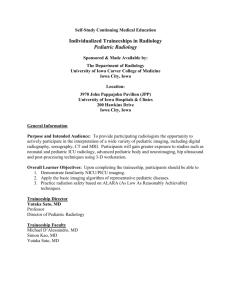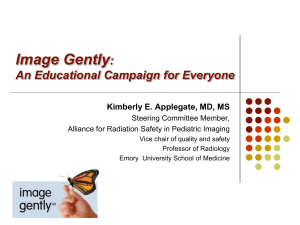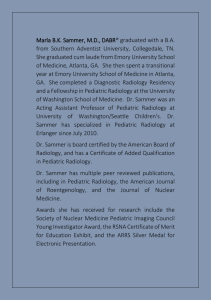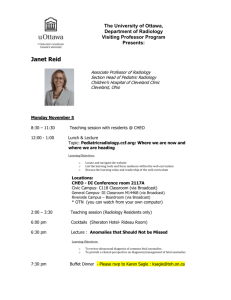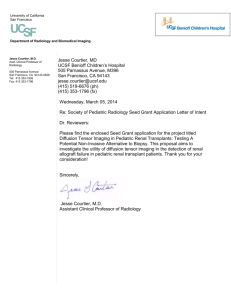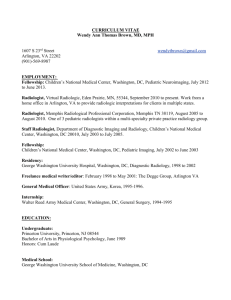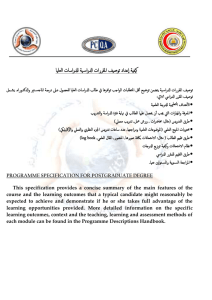Pediatric Radiology
advertisement
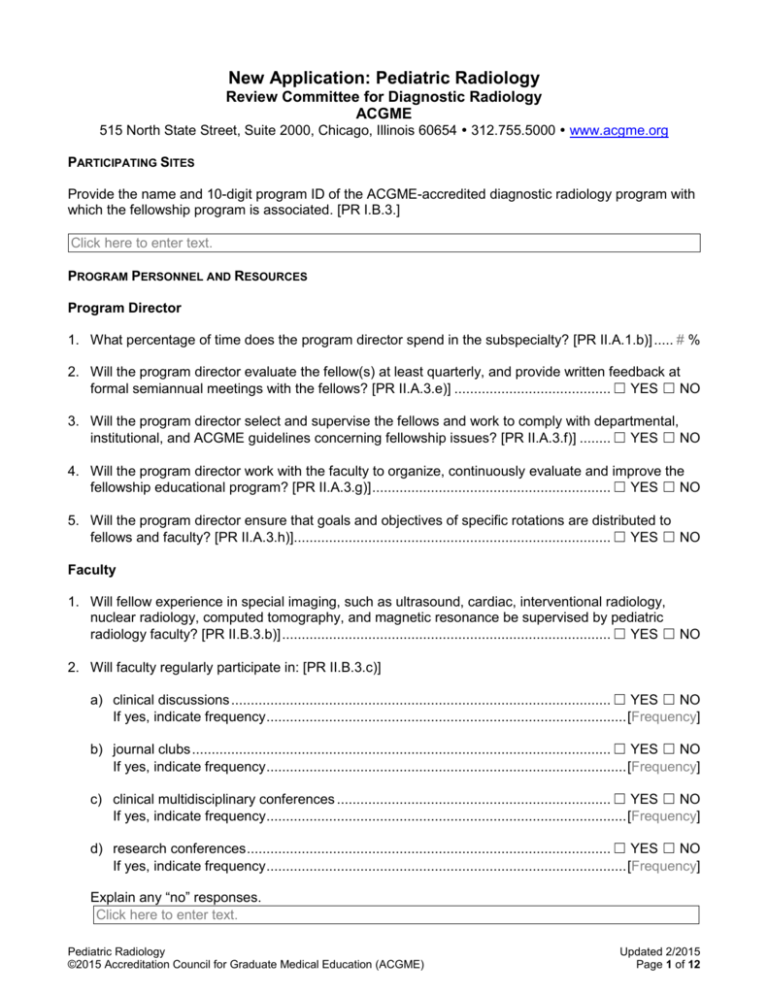
New Application: Pediatric Radiology Review Committee for Diagnostic Radiology ACGME 515 North State Street, Suite 2000, Chicago, Illinois 60654 312.755.5000 www.acgme.org PARTICIPATING SITES Provide the name and 10-digit program ID of the ACGME-accredited diagnostic radiology program with which the fellowship program is associated. [PR I.B.3.] Click here to enter text. PROGRAM PERSONNEL AND RESOURCES Program Director 1. What percentage of time does the program director spend in the subspecialty? [PR II.A.1.b)] ..... # % 2. Will the program director evaluate the fellow(s) at least quarterly, and provide written feedback at formal semiannual meetings with the fellows? [PR II.A.3.e)] ........................................ ☐ YES ☐ NO 3. Will the program director select and supervise the fellows and work to comply with departmental, institutional, and ACGME guidelines concerning fellowship issues? [PR II.A.3.f)] ........ ☐ YES ☐ NO 4. Will the program director work with the faculty to organize, continuously evaluate and improve the fellowship educational program? [PR II.A.3.g)] ............................................................. ☐ YES ☐ NO 5. Will the program director ensure that goals and objectives of specific rotations are distributed to fellows and faculty? [PR II.A.3.h)]................................................................................. ☐ YES ☐ NO Faculty 1. Will fellow experience in special imaging, such as ultrasound, cardiac, interventional radiology, nuclear radiology, computed tomography, and magnetic resonance be supervised by pediatric radiology faculty? [PR II.B.3.b)] .................................................................................... ☐ YES ☐ NO 2. Will faculty regularly participate in: [PR II.B.3.c)] a) clinical discussions ................................................................................................. ☐ YES ☐ NO If yes, indicate frequency ............................................................................................ [Frequency] b) journal clubs ........................................................................................................... ☐ YES ☐ NO If yes, indicate frequency ............................................................................................ [Frequency] c) clinical multidisciplinary conferences ...................................................................... ☐ YES ☐ NO If yes, indicate frequency ............................................................................................ [Frequency] d) research conferences ............................................................................................. ☐ YES ☐ NO If yes, indicate frequency ............................................................................................ [Frequency] Explain any “no” responses. Click here to enter text. Pediatric Radiology ©2015 Accreditation Council for Graduate Medical Education (ACGME) Updated 2/2015 Page 1 of 12 Other Program Personnel 1. Is there a program coordinator available to the program? [PR II.C.1.] .......................... ☐ YES ☐ NO If no, explain Click here to enter text. 2. Does the program coordinator have sufficient time and resources to support the administration and educational conduct of the program? [PR II.C.1.] ......................................................... ☐ YES ☐ NO If no, explain Click here to enter text. Resources 1. Patient Data [PR II.D] Reporting Period (Recent 12month period): From: Click here to enter a date. To: Click here to enter a date. Patient Examination Data Diagnostic Examinations TOTAL Adult Pediatric (Inc. neonatal) Site #1 Outpatient Inpatient # # Site #2 Outpatient Inpatient # # Site #3 Outpatient Inpatient # # # # # # Outpatient Only # # # # Outpatient Only # # # # Outpatient Only # # # # # # # # # # # # Number of Emergency Room Radiology Examinations (included above) Adult Pediatric (include neonatal) Pediatric Admissions 2. Briefly describe the facilities and space, including study space, conference space, and access to computers, available for the education of fellow. [PR II.D.1.a)] Click here to enter text. 3. List the number of units available to fellows in each site. Include units in other departments, e.g., cardiology, GI and GU. [PR II.D.1.] Diagnostic Radiology Equipment DR and CR radiographic units Portable radiographic units Fluoroscopic units C arm fluoroscopic units Pediatric Radiology ©2015 Accreditation Council for Graduate Medical Education (ACGME) Site #1 # # # # Site #2 # # # # Site #3 # # # # Updated 2/2015 Page 2 of 12 Diagnostic Radiology Equipment Interventional suite CT scanners in hospital complex (date of last purchased unit) CT scanners off site Ultrasound Equipment Number of units with color Doppler Portable units MRI Scanners Units on-site in hospital complex Units intra-operative Units available off-site Date of last purchase Nuclear Radiology Equipment Single head gamma Dual head gamma (SPECT/CT) PET/CT Uptake probe Site #1 # Site #2 # Site #3 # # # # # # # # # # # # # # # # # # # # # # # # # # # # # # # # # # # # # 4. Provide the data requested below regarding the number of procedures performed at each site that participates in the program for the most recent 12-month period. [PR. II.D.] Reporting Period (Recent 12month period): From: Click here to enter a date. To: Click here to enter a date. Procedure Magnetic Resonance Imaging L-spine with/without contrast L-spine with contrast L-spine with/without contrast Brain with contrast Brain with/without contrast Lower extremity w/joint without contrast Lower extremity w/joint with/without contrast MRA upper extremity MRA Lower extremity Cardiac MR Fetal MR TOTAL Computed tomography Chest with contrast Chest without contrast Abdominal without contrast abdominal with contrast pelvis with contrast pelvis without contrast CPT Code Site #1 Site #2 Site #3 72148 72149 72158 70552 70553 73721 73723 73225 73725 75557 72195 # # # # # # # # # # # # # # # # # # # # # # # # # # # # # # # # # # # # 71260 71250 74150 74160 72193 72192 # # # # # # # # # # # # # # # # # # Pediatric Radiology ©2015 Accreditation Council for Graduate Medical Education (ACGME) Updated 2/2015 Page 3 of 12 Procedure CT head without contrast CPT Code 70450 Site #1 # # Site #2 # # Site #3 # # 78740 78815, 78816 78306 # # # # # # # # # # # # 74240 74283 49440 # # # # # # # # # # # # # # # # # # # # # # # # # # # # # # # # # # # # # TOTAL Nuclear medicine Nuc cysto PET/CT – skill to thigh & whole body Bone scan, whole body TOTAL Fluoro UGI Therapeutic enema G-tube placement Ultrasound Renal Abdomen Head Hips Fetal 76770 76700 76506 76886 76815 TOTAL Radiography Chest 1 view Chest 2 view Skeletal survey 71010 71020 77075 TOTAL # # # # # 5. Does the sponsoring institution also sponsor an ACGME-accredited pediatric residency? [PR II.D.2.] ................................................................................................................... ☐ YES ☐ NO 6. List the ACGME-accredited pediatric residency program(s), and pediatric medical and surgical fellowship programs in the institution and the number of fellows in each. Add additional rows as necessary. [PR II.D.2.] ACGME-Accredited Programs Residents/Fellows 7. How many pediatric surgeons are available at the sponsoring institution? [PR II.D.2.] ................. [ # ] 8. How many pediatric pathologists are available at the sponsoring institution? [PR II.D.2.] ............. [ # ] 9. List other types of pediatric medical and surgical subspecialists available at the sponsoring institution. [PR II.D.2.] Click here to enter text. Pediatric Radiology ©2015 Accreditation Council for Graduate Medical Education (ACGME) Updated 2/2015 Page 4 of 12 10. How will the program director ensure the subspecialty program in pediatric radiology will not dilute or detract from the educational opportunities available to residents in the core diagnostic radiology resident program? [PR III.B.3.] Click here to enter text. 11. Briefly describe the interaction the fellowship program will have a diagnostic radiology residency program. [PR III.B.5.] Click here to enter text. Medical Information Access Describe resources available for point of service teaching and learning utilized during read out session. The description should include the availability of electronic resources. [PR II.E.] Click here to enter text. FELLOW APPOINTMENTS 1. What is the total number of radiology residents that rotate through pediatric radiology per year? [PR I.B.3; III.B.2] .......................................................................................................................... [ # ] a) Average length of rotation: ............................................................................................... [Length] 2. If the pediatric radiology program is sponsored by a diagnostic radiology residency program, explain the distinction between the residents and the pediatric radiology fellows in terms of clinical activities and level of responsibility. [PR III.B.4.] Click here to enter text. 3. Will pediatric radiology fellows have shared experiences with pediatric residents and fellows in pediatric-related subspecialties (i.e. surgery, pathology, neonatology, general pediatrics, and adolescent medicine) and cardiology? [PR III.B.5.a)] (Note that programs will not be cited for failure to provide this experience) ........................................................................................... ☐ YES ☐ NO EDUCATIONAL PROGRAM For the competency tables below, examples of evaluation methods for competence may include: direct observation, global assessment, multisource assessment, practice/billing audit, patient survey, record/chart review, review of patient outcomes, simulations/models, structured case discussion, inhouse written examination, In-training examination, oral examination and computer-based learning. Patient Care 1. For the patient care and procedural areas listed in the table below, identify the learning activities, settings and evaluation methods for the fellows. Pediatric Radiology ©2015 Accreditation Council for Graduate Medical Education (ACGME) Updated 2/2015 Page 5 of 12 CORE CURRICULUM Provide consultation with referring physicians or services [PR IV.A.2.a).(1).(a). Educate diagnostic radiology residents, and if appropriate, medical students and other professional personnel in the care and management of patients [PR IV.A.2.a).(1).(b)] Follow standards of care for practicing in a safe environment, attempt to reduce errors, and improve patient outcomes [PR IV.A.2.a).(1).(c)] Interpret all exams and/or invasive studies under close, graded responsibility and supervision; [PR IV.A.2.a).(1).(d)] Assume direct and progressive responsibility in pediatric imaging as they advance through training that culminates in sufficiently independent responsibility for clinical decision making [PR IV.A.2.a).(1).(e)] Apply low dose radiation techniques for both adults and children [PR IV.A.2.a).(2).(a)] Perform all exams and/or invasive studies under close, graded responsibility and supervision [PR IV.A.2.a).(2).(b)] List in Bulleted Format the Learning Activities and Settings Used to Address the Core Knowledge Areas for Patient Care and Procedures Click here to enter text. List in Bulleted Format the Method(s) Used to Evaluate Fellow Competency Click here to enter text. Click here to enter text. Click here to enter text. Click here to enter text. Click here to enter text. Click here to enter text. Click here to enter text. Click here to enter text. Click here to enter text. Click here to enter text. Click here to enter text. Click here to enter text. Click here to enter text. 12. Briefly describe how fellows will provide consultation with referring physicians or services. [PR IV.A.2.a).(1).(a)] Click here to enter text. 13. Describe how fellows will be educated in and apply low dose radiation techniques in both adults and children and how they become skilled in preventing and treating complications of contrast administration. [PR IV.A.2.a).(2).(a), IV.A.2.b).(2)] Pediatric Radiology ©2015 Accreditation Council for Graduate Medical Education (ACGME) Updated 2/2015 Page 6 of 12 Limit to 200 words Click here to enter text. 14. Briefly describe how fellows will be provided with direct and progressive responsibility on pediatric imaging as they advance though the program? [PR IV.A.2.a).(1).(e)] Click here to enter text. Medical Knowledge 1. Describe the activities and settings in which fellows will be given opportunities to develop knowledge in the following topics and evaluation methods used. List in Bulleted Format the Learning Activities and Settings Used to Address the CORE CURRICULUM Core Knowledge Area Demonstrate a level of expertise Click here to enter text. in the knowledge of those areas appropriate for a radiologist specialist [PR IV.A.2.b).(1)] Demonstrate knowledge in low- Click here to enter text. dose radiation techniques for both adults and children, and learn how to prevent and/or treat complications of contrast administration [PR IV.A.2.b).(2)] Prepare and present educational Click here to enter text. material for medical students, graduate medical staff, and allied health personnel [PR IV.A.2.b).(3)] Participate in teaching Click here to enter text. conferences for medical students, radiology residents, other residents rotating on the pediatric radiology service, and other health professional training programs [PR IV.A.2.b).(3).(a.)] Utilize appropriate imaging as it Click here to enter text. is applied to congenital, developmental, or acquired diseases of the newborn, infant, child, and adolescent that are basic to the practice of pediatrics [PR IV.A.2.b).(4)] Interpret imaging studies of the Click here to enter text. pediatric patient with awareness Pediatric Radiology ©2015 Accreditation Council for Graduate Medical Education (ACGME) List in Bulleted Format the Method(s) Used to Evaluate Fellow Competency Click here to enter text. Click here to enter text. Click here to enter text. Click here to enter text. Click here to enter text. Click here to enter text. Updated 2/2015 Page 7 of 12 CORE CURRICULUM of normal, normal variants, and typical imaging findings of pediatric diseases and congenital malformations [PR IV.A.2.b).(5)] List in Bulleted Format the Learning Activities and List in Bulleted Format the Settings Used to Address the Method(s) Used to Evaluate Core Knowledge Area Fellow Competency 2. Briefly describe fellow experience utilizing appropriate imaging as it is applied to congenital, developmental or acquired diseases of the newborn, infant, child, and adolescent. [PR IV.A.2.b).(4)] Click here to enter text. 3. Briefly describe fellow experience in interpreting imaging studies of the pediatric patient with awareness of normals, normal variants, and typical imaging findings of pediatric diseases and congenital malformations. [PR IV.A.2.b).(5)] Click here to enter text. Interpersonal and Communication Skills Describe the activities and settings in which fellows will be given opportunities to develop knowledge in the following topics and evaluation methods used. List in Bulleted Format the Learning Activities and Settings Used to Address the Core Knowledge Area Click here to enter text. CORE CURRICULUM Communicate effectively with patients, parents, colleagues, referring physicians, and other members of the health care team concerning imaging and procedure appropriateness, informed consent, safety issues, and the results of imaging tests or procedures [PR IV.A.2.d).(1)] Competence in oral communication judged through direct observation [PR IV.A.2.d).(2)] Competence in written communication judged on the basis of the quality and timeliness of dictated reports [PR IV.A.2.d).(3)] Understanding of techniques that improve understanding of ageappropriate behaviors for the List in Bulleted Format the Method(s) Used to Evaluate Fellow Competency Click here to enter text. Click here to enter text. Click here to enter text. Click here to enter text. Click here to enter text. Click here to enter text. Click here to enter text. Pediatric Radiology ©2015 Accreditation Council for Graduate Medical Education (ACGME) Updated 2/2015 Page 8 of 12 CORE CURRICULUM pediatric patient, and sensitivity to the needs of parents and patients [PR IV.A.2.d).(4)] Understanding of the cultural, economic and intellectual/educational differences [PR IV.A.2.d).(5)] Plan and present conferences [PR IV.A.2.d).(6)] List in Bulleted Format the Learning Activities and Settings Used to Address the Core Knowledge Area List in Bulleted Format the Method(s) Used to Evaluate Fellow Competency Click here to enter text. Click here to enter text. Click here to enter text. Click here to enter text. Professionalism Describe the activities and settings in which fellows will be given opportunities to develop skills in the following topics. CORE CURRICULUM Compassion, integrity and respect for others [PR IV.A.2.e).(1)] Responsiveness to patient needs [PR IV.A.2.e).(2)] Respect for patient privacy and autonomy [PR IV.A.2.e).(3)] Accountability to patients, society, and the profession [PR IV.A.2.e).(4)] Sensitivity and responsiveness to a diverse patient population, including but not limited to diversity in gender, age, culture, race, religion, disabilities, and sexual orientation [PR IV.A.2.e).(5)] Compliance with institutional and departmental policies, HIPAA, The Joint Commission, patient safety, infection control, etc.) [PR IV.A.2.e).(6)] List in Bulleted Format the Learning Activities Used to Address the Core Knowledge Area Click here to enter text. List the Corresponding Setting(s) in Which These Learning Activities Take Place Click here to enter text. Click here to enter text. Click here to enter text. Click here to enter text. Click here to enter text. Click here to enter text. Click here to enter text. Click here to enter text. Click here to enter text. Click here to enter text. Click here to enter text. Systems-based Practice Pediatric Radiology ©2015 Accreditation Council for Graduate Medical Education (ACGME) Updated 2/2015 Page 9 of 12 Describe the activities and settings in which fellows will be given opportunities to develop skills in the following topics. List in Bulleted Format the Learning Activities Used to Address the Core Knowledge Area Click here to enter text. CORE CURRICULUM Work in interprofessional teams to enhance patient safety and improve patient care quality [PR IV.A.2.f).(1)] Participate in identifying system errors and implementing potential systems solutions [PR IV.A.2.f).(2)] Click here to enter text. List the Corresponding Setting(s) in Which These Learning Activities Take Place Click here to enter text. Click here to enter text. Curriculum 1. Explain how training will be provided in each of these pediatric imaging areas (assignment in each of these areas should include participation in and responsibility for dictation of reports): [PR Int.B.4.] a) radiography Click here to enter text. b) computed tomography Click here to enter text. c) ultrasonography Click here to enter text. d) vascular interventional techniques Click here to enter text. e) nuclear radiology, including positron emission tomography Click here to enter text. f) magnetic resonance imaging Click here to enter text. f) other imaging modalities if applicable Click here to enter text. 2. If there are outside rotations, describe the fellows' duties and level of responsibility during each of the outside assignments. [PR IV.A.3.a).(1)] Click here to enter text. 3. Do conferences include: a) Intradepartmental conferences [PR IV.A.3.d).(1)] ................................................... ☐ YES ☐ NO If yes, how frequently does this occur? ....................................................................... [Frequency] Pediatric Radiology ©2015 Accreditation Council for Graduate Medical Education (ACGME) Updated 2/2015 Page 10 of 12 b) Departmental grand rounds [PR IV.A.3.d).(2)] ........................................................ ☐ YES ☐ NO If yes, how frequently does this occur? ....................................................................... [Frequency] c) At least one interdisciplinary conference per week [PR IV.A.3.d).(3)] ..................... ☐ YES ☐ NO d) Peer-review case conference and/or M&M conference [PR IV.A.3.d).(4)]............... ☐ YES ☐ NO If yes, how frequently does this occur? ....................................................................... [Frequency] 4. Briefly describe the policy for fellow attendance and participation at local and national meetings. Indicate whether the program provides reimbursement. [PR IV.A.3.e).-IV.A.3.e).(1)] Click here to enter text. 5. Formal didactic sessions Enter the schedule of planned conferences and lectures. The specific title of lectures/sessions is requested. Add additional rows as necessary. [PR IV.A.3.f)-IV.A.3.f).(2)] Reporting Period (Planned 12From: month period): Type and Frequency To: Title Fellows’ Scholarly Activities Describe how fellows will be instructed in the fundamentals of experimental design, performance, and interpretation of results. [PR IV.B.1.] Click here to enter text. EVALUATION Fellow Formative Evaluation 1. Will fellow evaluations include at least a quarterly review? [PR V.A.1.b).(3).(a)]........... ☐ YES ☐ NO 2. Will the quarterly review include the following? [PR V.A.1.b).(3).(b)-V.A.1.b).(3).(b).(iv)] a) review of the faculty’s evaluations of the fellow ...................................................... ☐ YES ☐ NO b) review of the fellow’s procedure log........................................................................ ☐ YES ☐ NO c) documentation of compliance with institutional and department policies (e.g. HIPAA, the JC, patient safety, infection control, etc.] ...................................................................... ☐ YES ☐ NO d) review of procedural competencies or other simulation learning ............................. ☐ YES ☐ NO Pediatric Radiology ©2015 Accreditation Council for Graduate Medical Education (ACGME) Updated 2/2015 Page 11 of 12 Explain any “no” responses. Click here to enter text. Faculty Evaluation 1. Will faculty evaluations include a written confidential evaluation by the fellows? [PR V.B.3.] .................................................................................................................................... ☐ YES ☐ NO 2. Will faculty receive annual feedback from these evaluations? [PR V.B.3.].................... ☐ YES ☐ NO Explain any “no” responses. Pediatric Radiology ©2015 Accreditation Council for Graduate Medical Education (ACGME) Updated 2/2015 Page 12 of 12

